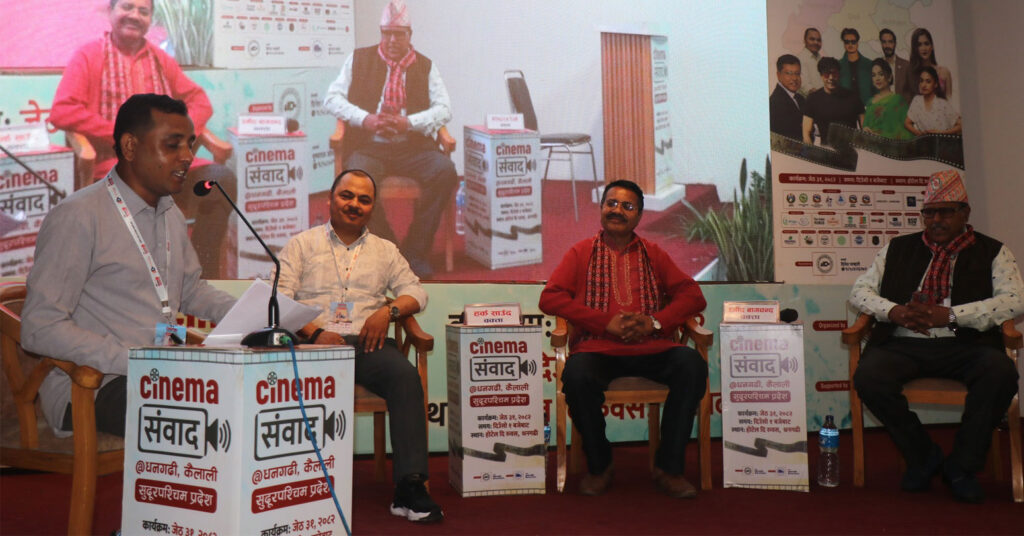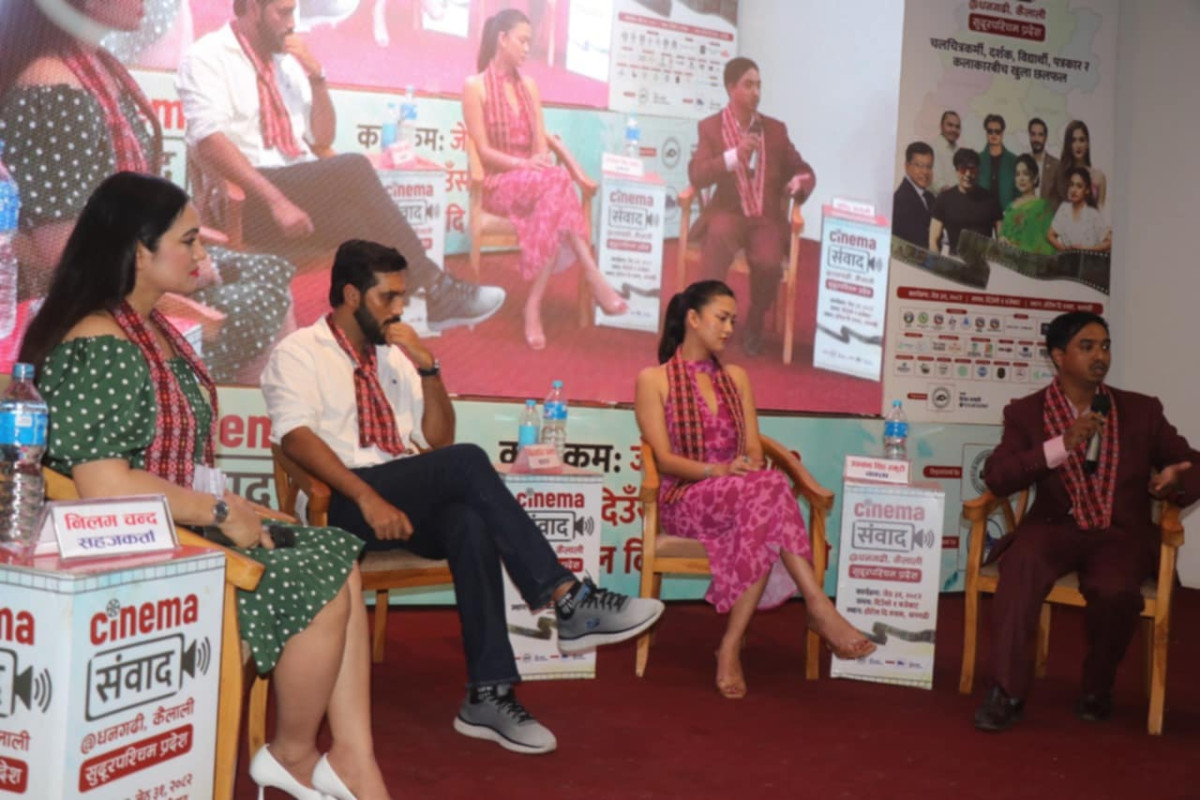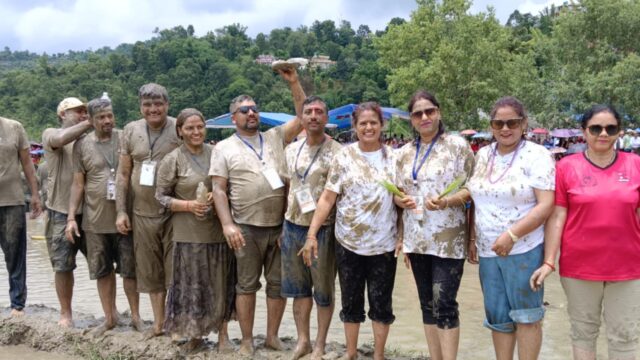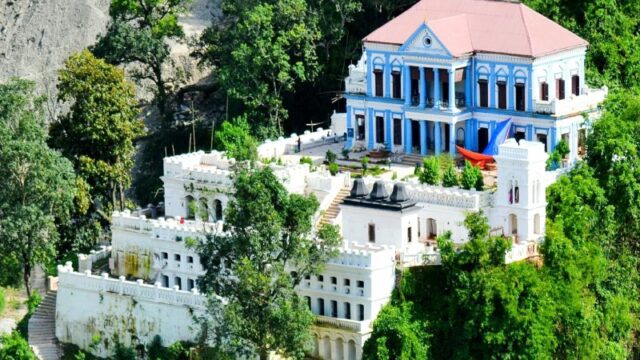In a special program titled ‘Cinema Dialogue’ held in Dhangadhi, stakeholders from the Nepali film industry, journalism, literature, and local governance underscored the significant role of cinema in preserving local culture and promoting tourism. The event provided a common platform for filmmakers, actors, students, critics, and tourism promoters to discuss how cinema can be used as a powerful medium to reflect the art, history, and lifestyle of Sudurpashchim Province.
Cinema as a Medium to Promote Local Identity
Participants agreed that movie can go beyond entertainment to shed light on local narratives, languages, and cultural practices. Since many parts of Sudurpashchim remain “virgin territories” for cinematic storytelling, the region offers vast opportunities for filmmakers seeking authentic and unexplored backdrops.
The dialogue emphasized the importance of highlighting indigenous themes and traditions through film, thereby creating awareness and interest not only among Nepali audiences but also international tourists and viewers. The speakers stressed that integrating touristic destinations like Khaptad, Api and Saipal Himal, Ramaroshan, Dodhara Chandani suspension bridge, Karnali bridge, and Shuklaphanta into storylines could boost local tourism while celebrating the province’s unique identity.
Discussions on Content, Technology, and Social Impact
The program featured dynamic discussions on a range of subjects, from filmmaking trends and evolving technologies to audience expectations and social influence. It focused on how new-generation filmmakers are reshaping Nepali cinema with fresh narratives and how digital technology is redefining both production and distribution in the industry.
Actors Upasana Singh Thakuri and Divya Dev Pant, along with Film Journalist Association President Sameer Wali and journalist Neelam Chand, actively participated in discussions surrounding new-age movie, audience behavior, and challenges posed by shifting entertainment platforms. The speakers emphasized the need for movie with social relevance that simultaneously reflects the country’s diverse geography and cultural roots.
Debates on Sudurpashchim’s History and Language in Cinema
In a dedicated session focused on the representation of Sudurpashchim’s history and culture, veteran journalist Sitaram Ojha, writer Hemant Bibas, director Nawal Nepal, and actor Pushpa Khadka expressed the need to include regional stories in national cinema. They discussed the lack of representation of the province’s cultural heritage in mainstream Nepali films and called for intentional storytelling that honors the values and languages of the far-west.
Director Nawal Nepal used the platform to announce his upcoming film project, which will be shot in the natural landscapes of Sudurpashchim and based on local cultural themes. The initiative aims to set a precedent for incorporating regional flavor and authenticity into national film production.

Spotlight on Doteli Language, Deuda Songs, and Folk Traditions
Another session focused on the role of Doteli language and local music in cinema. Discussions featured journalist Sitaram Ojha, lyricist Hark Saud, folk singer Narendraraj Regmi, and journalist Umeed Bagchand. The panelists emphasized the cultural richness of Deuda music, expressing concern over its fading prominence in modern entertainment.
They called for dedicated efforts to include original Doteli songs and dialogues in films, not only to revive the language but also to connect with local audiences in a meaningful way. The session also highlighted how authentic folk music can elevate storytelling in cinema and create a deeper cultural impact.
Tourism Through the Cinematic Lens
The fourth session revolved around the impact of movie on tourism promotion in Sudurpashchim. Panelists Takendra Deuba (journalist), Saraswati Khadka (artist), Khadkabahadur Malla (producer of Doteli film Gauri), and Prem Chaudhary (Tharu film actor) discussed how showcasing natural and cultural heritage through cinema could significantly increase tourist interest in the region.
They identified major attractions, including Dodhara Chandani’s suspension bridge, Api and Saipal Himalayan range, Khaptad National Park, Karnali bridge, Ramaroshan wetland, and Shuklaphanta Wildlife Reserve, as key sites with untapped cinematic potential. Films that incorporate these locations can enhance the visibility of Sudurpashchim as a tourist-friendly region and promote rural economies through tourism.
Organizers Aim to Bridge City and Village Through Cinema
The event was jointly organized by the Film Journalists Association Nepal, Kailali Chapter, and JDA Associates, marking the first cinema dialogue of its kind in the province. Organizer Pushparaj Joshi, President of the Association, and Dinesh Bhandari, Head of JDA Associates, expressed their commitment to using cinema as a tool for cultural preservation and promotion.
Opening the program, Chairperson of Jorayal Rural Municipality, Durga Datt Ojha, urged filmmakers to shift the focus from urban-centric narratives to village-based stories, so that the voices of rural Nepal also find space on the big screen. He emphasized the importance of integrating local identity into national cinema to bridge the gap between the capital and the countryside.
A New Horizon for Regional Cinema
The ‘Cinema Dialogue’ held in Dhangadhi opened meaningful conversations about the future of Nepali cinema and its role in shaping social identity, preserving heritage, and driving tourism. With active participation from artists, filmmakers, journalists, and local leaders, the event created a platform for regional voices to be heard and encouraged collaborative storytelling that resonates deeply with local and global audiences alike.
As Nepal’s film industry continues to evolve, initiatives like this dialogue reflect the growing recognition that regional culture, when authentically portrayed, holds the power to transform both cinema and tourism. The success of this event sets a positive precedent for future engagements across other provinces.






